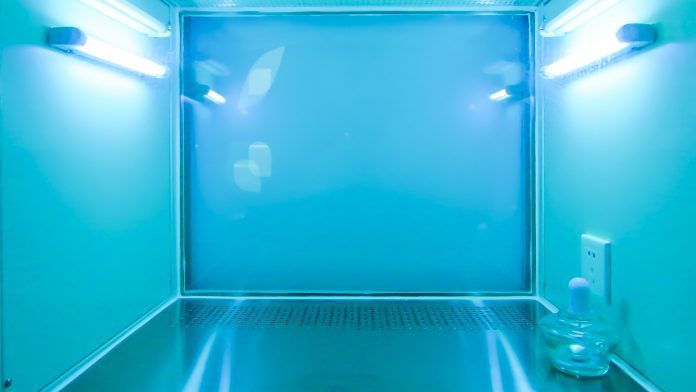
Troy Cowan, coordinator of the Ultraviolet Working Group at the International Ultraviolet Association outlines the integral role of UV-C air disinfection in fighting the spread of airborne diseases.
The COVID-19 pandemic has presented opportunities for the wider adoption of UV-C disinfection technologies, resulting in tremendous growth in the number and diversity of UV-C sources and devices available worldwide.1 Recognition that COVID-19’s infection pathway is primarily airborne,2 has led to new US initiatives aimed at improving indoor air quality; and the UV-C disinfection industry has responded.
That COVID-19 is serious business was really brought home by Dr Edward Nardell in a recent TIME magazine article where he stated: ‘COVID variants may be with us for years to come… So, we need to think clearly and scientifically about how better we can reduce the spread of viruses indoors.’3
Similarly, Dr Georg Niedermeier said: ‘This battle is an urgent matter… UV-C technology can be vital in mitigating and preventing many more current and future airborne diseases. COVID-19 will not likely be the last pandemic.’4
This author strongly agrees with these ‘calls to preventive action’ for the following reasons:
- Waves of new infection cases have already been detected in Europe and Hong Kong5 due, in part, to the highly infectious BA.2 Omicron subvariant6 and slowing vaccinations,7 implying infection rates will likely rise soon;8
- Once infected, many COVID patients experience long-term debilitating effects such as damage to the lungs, heart, nervous system, kidneys, liver, and other organs,9 with potentially severe consequences for people with heart conditions;10
- Treating new infections may be a problem, as Omicron BA.2 has already been found to be resistant to at least one commonly prescribed treatment,11 making it an antibiotic/antimicrobial resistant (AR/AMR) pathogen. More may be coming. The US Centers for Disease Control and Prevention (CDC) notes that AR/AMR pathogens cause more than 2.8 million infections in the US every year, and over 35,000 fatalities; and12
- In 2019, the World Health Organization (WHO) reported to the Secretary General of the United Nations on the AR/AMR situation, stating ‘Alarming levels of resistance have been reported in countries of all income levels, with the result that common diseases are becoming untreatable, and lifesaving medical procedures riskier to perform.’13
In response, the US President initiated a nationwide programme for improving indoor air quality to combat COVID-19,14 implemented through the US Environmental Protection Agency’s (EPA’s) Clean Air Building Challenge.15 In this challenge, EPA describes several methods to enhance indoor air quality, but sadly neglects UV-C air disinfection options and benefits.16
As a counterpoint, we would remind EPA that UV-C air disinfection technologies are proven ‘…to markedly reduce the spread of measles—the most infectious of airborne respiratory viruses.’17 Further, upper-room UV-C can continuously disinfect the air, even in occupied spaces, minimising airborne person-to-person spread of the virus(es) in the room, compared to in-duct units that only disinfect when the HVAC is circulating air.18 Even the CDC recommends UV-C upper air technologies in its Guidance on Upper-Room UVGI Implementation, so it is truly a credible approach to air disinfection.19
Why is UV-C so important?
UV-C is a known, tested technology, used effectively for almost 100 years with documented evidence it reduces airborne infections of all types,20 and is accepted by CDC.21 UV-C irradiance, when used appropriately with normal cleaning regimens,22 is highly effective in controlling pathogens of all types,23 rendering them incapable of replication24 (it is assumed that if they cannot replicate, they cannot create UV-C resistant variants; further research is needed to confirm this assumption).
On safety, it is well understood that UV-C has ‘potential to cause temporary eye or skin damage’25 if exposures exceed accepted limits. However, newly issued international guidelines for exposure limits26, 27 make UV-C technologies much more acceptable for treating public spaces, both unoccupied and occupied.28
We know more airborne pathogens are coming, and we expect they will be more antibiotic/antimicrobial resistant, resulting in higher infection rates and increasingly serious complications that may not be treatable. The risks are great, the solution is simple – prevention. Would it not make more sense to do what we can to prevent the next spread? One very direct way is through better air treatment, and UV-C can help.
References
- Meadows, “Lighting for wellbeing expands into the ultraviolet in 2020,” LEDs Magazine, 11 Dec 2020, www.ledsmagazine.com/blogs/article/14188761/lighting-for-wellbeing-expands-into-the-ultraviolet-in-2020
- Nardell, “Disinfection using Ultraviolet Radiation, W.H.O. Webinar” 17 Dec 2021, who.zoom.us/rec/share/jJ-g1XfEdxMHIE9UaihXiFZ8fQvDLtrjofThW9QpH3m0dgdlxsRKlZHt0pWpJtUC.VXXhGvIX4EvLX41W, last accessed 29 March 2022
- Nardell, “If We’re Going to Live With COVID-19, It’s Time to Clean Our Indoor Air Properly,” TIME magazine, 1 Feb 2022, time.com/
6143799/covid-19-indoor-air-cleaning/, last accessed 29 March 2022 - Niedermeier, et. al., “UV-C: Disinfection Benefits, Safety, Comfort and Proof Points,” LEDS Professional Review, Mar/April 2021, www.lightingeurope.org/images/publications/general/LpR84_UV-C_Disinfection_Benefits_Safety_-_March_2021.pdf, last accessed 29 March 2022
- Frieden, “The Next Covid Wave Is Probably Already on Its Way,” New York Times Opinion Guest Essay, 22 March 2022, www.nytimes.com/2022/03/22/opinion/covid-surge-prep.html, last accessed 29 March 2022
- Zimmer, “‘Stealth’ Omicron Is Stealthy No More: What’s Known About the BA.2 Variant”, New York Times, 18 Mar 2022, www.nytimes.com/article/omicron-variant-ba2.html, last accessed 29 March 2022
- Frieden, 22 March 2022, cited above
- Leonhardt, “Reducing Covid’s Toll – Many experts expect Covid caseloads to rise soon. Here are four steps to protect people,” New York Times, 28 March 2022, www.nytimes.com/2022/03/28/briefing/covid-omicron-caseload-antiviral-pills.html, last accessed 29 March 2022
- Chung, et. al., “COVID ‘Long Haulers’: Long-Term Effects of COVID-19,” Johns Hopkins Medicine Health Website, www.hopkinsmedicine.org/health/conditions-and-diseases/coronavirus/covid-long-haulers-long-term-effects-of-covid19, last updated 8 Dec. 2021, last accessed 29 March 2022
- O’Donnell, “Scientists: COVID-19 may cause greater damage to the heart,” Modern Healthcare, 28 March 2022, 8:46am, www.modernhealthcare.com/clinical/scientists-covid-19-may-cause-greater-damage-heart, last accessed 29 March 2022
- Money & Rong-Gong Lin, “Ultra-contagious BA.2 Omicron strain adds urgency to second booster shot,” Los Angeles Times, 30 March 2022, www.latimes.com/california/story/2022-03-30/l-a-begins-offering-2nd-boosters-to-older-adults-as-ba-2-dominates-in-u-s, last accessed 30 March 2022
- US CDC, “Antibiotic / Antimicrobial Resistance (AR/AMR), About Antibiotic Resistance”, last reviewed: December 13, 2021, www.cdc.gov/drugresistance/about.html, last accessed 30 March 2022
- World Health Organization, “No Time to Wait: Securing the Future from Drug-Resistant Infections,” Interagency Coordination Group on Antimicrobial Resistance, World Health Organization, Report to the Secretary-General of the United Nations, April 2019 (www.who.int/docs/default-source/documents/no-time-to-wait-securing-the-future-from-drug-resistant-infections-en.pdf) last accessed 29 March 2022.
- US White House, “FACT SHEET: Biden Administration Launches Effort to Improve Ventilation and Reduce the Spread of COVID-19 in Buildings,” 17 March 2022, www.whitehouse.gov/briefing-room/statements-releases/2022/03/17/fact-sheet-biden-administration-launches-effort-to-improve-ventilation-and-reduce-the-spread-of-covid-19-in-buildings/, last accessed 29 March 2022
- US EPA, “Clean Air in Building Challenge,” March 22, www.epa.gov/indoor-air-quality-iaq/clean-air-buildings-challenge, last accessed 29 March 2022
- Ibid.
- Nardell, 1 Feb 2022, cited above
- Nardell, 17 Dec 2021, cited above
- US CDC, “Upper-Room Ultraviolet Germicidal Irradiation (UVGI)”, last updated 9 April 2021, www.cdc.gov/coronavirus/2019-ncov/community/ventilation/uvgi.html, last access 29 March 2022
- Anderson, “Ultraviolet Air Disinfection (1949),” Postgraduate Medicine, 5:1, 27-32, DOI:10.1080/00325481.1949.11693746 (www.tandfonline.com/action/owCitFormats?doi=10.1080%2F00325481.1949.11693746 )
- US CDC, 9 April 2021, cited above.
- Ibid.
- Anderson, DOI:10.1080/00325481.1949.11693746, cited above
- Niedermeier, Mar/April 2021, cited above
- US CDC, 9 April 2021, cited above.
- Sliney & Stuck, “A Need to Revise Human Exposure Limits for Ultraviolet UV-C Radiation,” Photochemistry and Photobiology, Volume 97/Issue 3, 16 Feb 2021, doi.org/10.1111/php.13402, last accessed 29 March 2022
- American Conference of Governmental Industrial Hygienists (ACGIH), “2022 Notice of Intended Changes List (NICs),” www.acgih.org/science/tlv-bei-guidelines/documentation-publications-and-data/notice-of-intended-changes/notice-of-intended-changes-list/, last accessed 29 March 2022
- Nardell, 1 Feb 2022, cited above
Troy Cowan
Coordinator
IUVA’s Healthcare/UV Working Group
International Ultraviolet Association
www.iuva.org
This article is from issue 21 of Health Europa Quarterly. Click here to get your free subscription today.
























